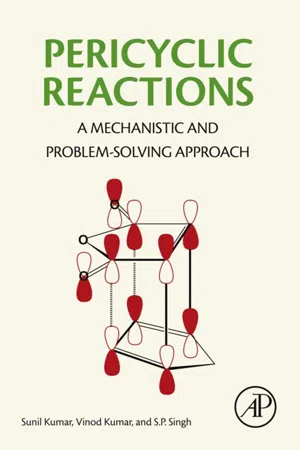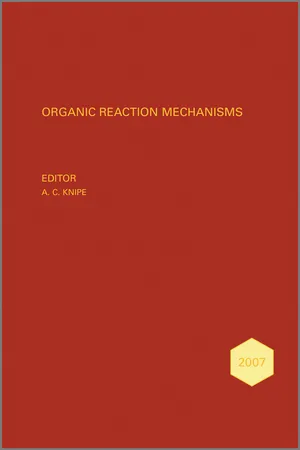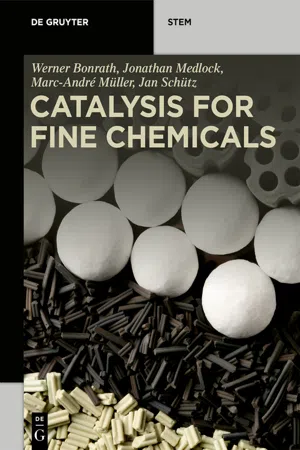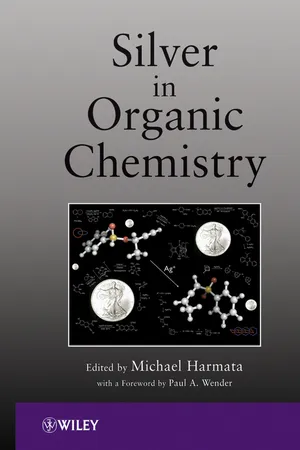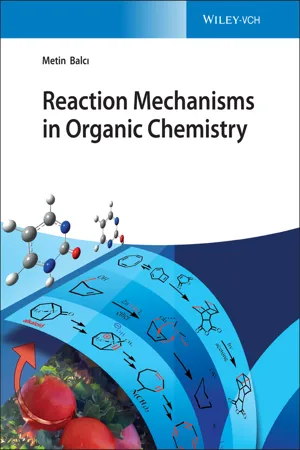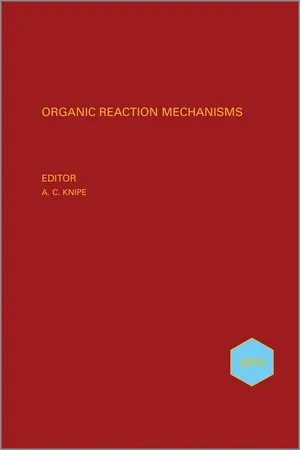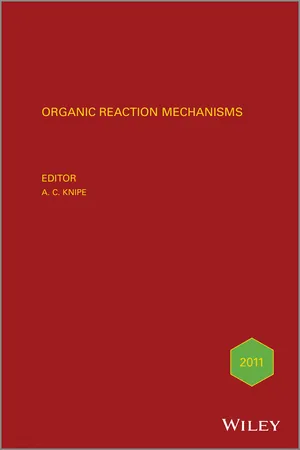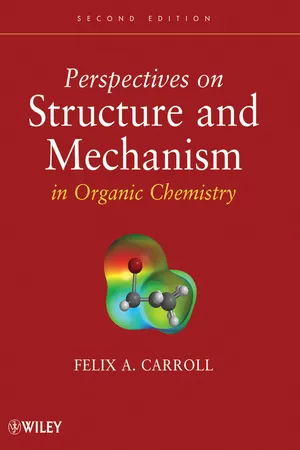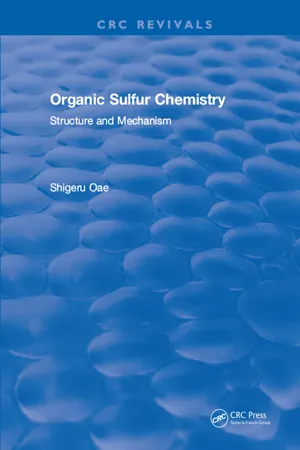Chemistry
2 3 Sigmatropic Rearrangement
The 2 3 Sigmatropic Rearrangement is a chemical reaction that involves the migration of a substituent from one carbon atom to an adjacent carbon atom. This rearrangement occurs through a concerted process, where the breaking and forming of bonds happen simultaneously. It is a useful tool in organic synthesis for creating complex molecules.
Written by Perlego with AI-assistance
Related key terms
Related key terms
1 of 4
Related key terms
1 of 3
9 Key excerpts on "2 3 Sigmatropic Rearrangement"
- eBook - ePub
Pericyclic Reactions
A Mechanistic and Problem-Solving Approach
- Sunil Kumar, Vinod Kumar, S.P. Singh(Authors)
- 2015(Publication Date)
- Academic Press(Publisher)
3.4.4 Aza-Cope Rearrangement 1133.4.5 The Claisen Rearrangement 1153.4.6 Some Clever Variants of the Claisen Rearrangement 1293.5 [5,5] Sigmatropic Shift 1323.5.1 Solved Problems 1333.6 [2,3] Sigmatropic Rearrangements 1363.6.1 Solved Problems 1373.7 Peripatetic Cyclopropane Bridge: Walk Rearrangements 1393.7.1 Solved Problem 1413.8 Sigmatropic Rearrangements Involving Ionic Transition States 1423.8.1 Solved Problems 144Many thermal (or photochemical) rearrangements involve the shifting of a σ-bond, flanked by one or more π-electron systems, to a new position [i,j] within the molecule in an uncatalyzed intramolecular process. Since it is rearrangement of a σ-bond, these reactions are called sigmatropic rearrangements of order [i,j]. These reactions are often classified with two numbers, i and j, set in brackets [i,j] and the system is numbered by starting with the atoms forming the migrating σ-bond. These numbers [i and j] indicate the new positions of the σ-bond whose termini are i − 1 and j − 1 atoms removed from the original bonded loci (Scheme 3.1 ).Scheme 3.1 Sigmatropic rearrangements of order [1,3] and [1,5].Very often, the migrating σ-bond is situated in between two π-bond systems as in the Cope and the Claisen rearrangements (Scheme 3.2 ).Scheme 3.2 Sigmatropic rearrangements of order [3,3].3.1. Suprafacial and Antarafacial Processes
Since a sigmatropic reaction involves the migration of a σ-bond across the π-electron system, there are two different stereochemical courses by which the process may occur. When the migrating σ-bond moves across the same face of the conjugated system, it is called a suprafacial process whereas in antarafacial process the migrating σ-bond is reformed on the opposite π-electron face of the conjugated system . The following [1,5] sigmatropic shifts illustrate both these processes and their stereochemical consequences (Figure 3.1 - eBook - ePub
Organic Reaction Mechanisms 2007
An annual survey covering the literature dated January to December 2007
- A. C. Knipe, A. C. Knipe(Authors)
- 2011(Publication Date)
- Wiley(Publisher)
CHAPTER 13 Molecular Rearrangements: Part 1. Pericyclic Reactions S. K. Armstrong Formerly of Department of Chemistry, University of Glasgow[3,3]-Sigmatropic RearrangementsAll-carbon Pericyclic Systems One Heteroatom Two or More Heteroatoms[2,3]-Sigmatropic RearrangementsOther [n,m]-Sigmatropic Rearrangements[1,n ]-Sigmatropic RearrangementsBergman and Related Diradical RearrangementsElectrocyclic RearrangementsGroup Transfer ReactionsTandem Pericyclic RearrangementsReferencesThe 2006 literature on mechanisms of pericyclic reactions1 and the beneficial effect of an aqueous environment for pericyclic reactions, including sigmatropic rearrangements, have been reviewed.2 Multicentre electron delocalization indices have been used to characterize the aromatic transition states of a range of pericyclic processes, including four- and six-electron electrocyclic ring closures and [3,3]-sigmatropic rearrangements. Advantages over magnetic characterization have been reported.3[3,3]-Sigmatropic Rearrangements All-carbon Pericyclic SystemsQuantum chemical calculations on unsubstituted semibullvalene have suggested that complexation to a halogen molecule (X2 or XY) can remove the energy barrier for Cope rearrangement, giving a fairly flat potential energy surface with a delocalized minimum. Complexation of semibullvalene to some simple Lewis acids, or of barbaralane to halogens, was predicted to reduce the energy barrier for the Cope rearrangement, but not to remove it completely: the minima found were not delocalized.4 Quantum chemical calculations on Pd(II)-promoted Cope rearrangements of 2-substituted hexa-1,5-diene have suggested that charge separation usually occurs in an intermediate with positive charge on C(2), but that the intermediate occupies a very shallow potential well even when a cation-stabilizing substituent is present. With an electron-withdrawing substituent such as 2-F3C- or 2-NC-hexa-1,5-diene, the rearrangement was found to be concerted even with Pd(II) promotion, with charge separation occuring in the Pd-bound transition state.5 - eBook - ePub
- Werner Bonrath, Jonathan Medlock, Marc-André Müller, Jan Schütz(Authors)
- 2021(Publication Date)
- De Gruyter(Publisher)
7 Rearrangement reactions7.1 Introduction
Rearrangement reactions are a broad class of organic reactions in which the reactant undergoes a rearrangement to give a structural isomer of the original molecule via a migration of an H atom or a larger molecular fragment. From the view of atom economy and E-factor, rearrangement reactions fulfil the criteria of the modern type of chemistry and green chemistry, with all atoms of the starting material being present in the product structure.In many rearrangement reactions, the migration occurs directly to a neighbouring position. These rearrangements belong to the class of [1,2]-rearrangements or [1,2]-shifts. These reactions are often sigmatropic rearrangements meaning that a σ-bond migrates during the reaction. The nomenclature of rearrangement reactions is described by numbering the atoms directly attached to the bond that is broken with 1 and 1ʹ (Scheme 7.1 ). The following atoms in the direction of the rearrangement are labelled 2, 3 and so forth starting from 1 and 2ʹ, 3ʹ and so forth starting from 1ʹ. After the rearrangement the new σ-bond is connected to two atoms which characterise the rearrangement. The numbers are listed in square brackets and the prime is removed from the second number.Scheme 7.1: Naming and examples of sigmatropic rearrangements.Some of the most important industrial rearrangement reactions, such as [3,3]-sigmatropic rearrangements, are used in the synthesis of isoprenoid building blocks such as isophytol, β-ionone or aroma compounds such as methyl heptanone. These are the main focus of this chapter.7.2 Wagner–Meerwein rearrangements
The Wagner–Meerwein rearrangement is a predominately acid-catalysed [1,2]-rearrangement in which a hydrogen, alkyl or aryl group migrates from one carbon to a neighbouring carbon to generate a new carbocation. This carbocation reacts with a nucleophile or a proton from a neighbouring atom is eliminated. The driving force of the reaction is that the initially formed carbocation has the tendency to rearrange to a thermodynamically more stable structure. In the terpene chemistry, the Wagner–Meerwein rearrangement is of importance in the manufacture of camphene from isoborneol (Scheme 7.2 - eBook - ePub
- Michael Harmata, Michael Harmata(Authors)
- 2011(Publication Date)
- Wiley(Publisher)
Chapter 3 Sigmatropic Rearrangements and Related Processes Promoted by Silver Jean-Marc Weibel, Aurélien Blanc, and Patrick Pale Laboratory for Organic Synthesis and Reactivity, Institute of Chemistry, University of Strasbourg, France 3.1 IntroductionSigmatropic shifts represent a large class of reactions involving the migration of at least one sigma bond. Therefore, such migrations lead to skeletal rearrangements of the carbon frame within the molecule undergoing this reaction.Sigmatropic rearrangements usually involve σ bonds adjacent to a π system or a σ bond included in a strained system. As other transition metals, but with specific properties due to its d 10 electronic configuration, f orbitals and a relativistic effect,1 silver easily interacts with such systems. Silver salts have thus been explored as catalysts to facilitate and promote sigmatropic rearrangements.3.2 Wolff and Arndt–Eistert Rearrangements and Related ReactionsThe Wolff and Arndt–Eistert rearrangements are probably among the earliest known reactions promoted by silver ions.2, 3 Discovered at the turn of the nineteenth/twentieth century, the Wolff rearrangement allows the transformation of α-diazoketones to carboxylic acids,4 while the Arndt–Eistert rearrangement is a similar sequence also leading to carboxylic acids, but including the preparation of α-diazoketones from a shorter acid chloride (Scheme 3.1 ).5Scheme 3.1Numerous conditions have been developed for this transformation, but reproducible yields have usually been obtained by mixing a silver salt with a coreagent, such as silver nitrate associated with wet ammonia, silver oxide with triethylamine or sodium thiosulfate, and silver benzoate with triethylamine. Nonbasic conditions have also been described by Koch and Podlech using silver trifluoroacetate deposited on silica.6 - eBook - ePub
- Metin Balc?, Metin Balc?, Metin Balc?, Metin Balc?, Metin Balc?(Authors)
- 2021(Publication Date)
- Wiley-VCH(Publisher)
A general example of a sigmatropic shift is given below. Here, the hydrogen atom, together with the sigma electrons (as a hydride), shifts from the C1 carbon atom to the C5 atom through the conjugated system. This shift is called a sigmatropic [1,5] shift or [1,5] sigmatropic rearrangement. To cause a sigmatropic shift, the π system must be conjugated.According to the number of π electrons in the conjugated system involved in the reaction, sigmatropic shifts can also be [1,3], [1,5], or [1,7] shifts. The process is concerted, involving simultaneous cleavage of a σ bond and the formation of a new σ bond while the π bonds rearrange. Thus, a cyclic transition state structure is formed by combining both ends of the π system through a migrating group. Of course, the orbitals must have like phases for the formation of such a transition state.Let us assume that the π system has a planar structure; then, there can be two types of shifts. If the cleavage of the σ bond and its bonding to another carbon atom occurs on the same side of the plane, this shift is called a suprafacial shift. If the bonding occurs on the other side of the plane, this shift is called an antarafacial shift (Figure 10.30 ).Presentation of suprafacial and antarafacial shifts.Figure 10.30It is possible to determine which shift will occur using the Woodward–Hoffman rules. In the sigmatropic rearrangements, besides the π bond electrons, the migrating group's σ bond electrons also participate in the reaction. Therefore, we need to consider the [1,3] shift as an allyl anion and the [1,5] shift as a pentadienyl anion. To understand the site selectivity and stereochemistry observed in these reactions, it is necessary first to examine the HOMO–LUMO interaction of the system. The HOMO of the system (allyl anion) and the LUMO of the migrating group or vice versa have to be considered to find the symmetry-allowing process.For a [1,3] shift, we take the HOMO of the allyl system. As shown below, the orbital phase to which the hydrogen atom is bonded is not in the same phase as the orbital at the C3 carbon atom (Figure 10.31 ). According to the orbital symmetry, such a suprafacial shift is a thermally symmetry forbidden process. However, the Woodward–Hoffmann rules dictate that an antarafacial shift is an allowed process, but it is geometrically impossible (Figure 10.31 - eBook - ePub
Organic Reaction Mechanisms 2010
An annual survey covering the literature dated January to December 2010
- A. C. Knipe, A. C. Knipe(Authors)
- 2012(Publication Date)
- Wiley(Publisher)
Chapter 13 Molecular Rearrangements: Part 1. Pericyclic Reactions J. M. CoxonDepartment of Chemistry, University of Canterbury, Christchurch, New Zealand[3,3]-Sigmatropic, Claisen, and Cope Rearrangements [2,3]-Reactions Vinyl Cyclobutane and Vinyl Cyclopropane Rearrangement 1,2-Migration Ene Reaction Bergman Reaction Electrocyclic Reactions Cyclization 4 + 2-Cycloadditions 3 + 2-Cycloadditions Metathesis Metal-catalysed Reactions Miscellaneous References[3,3]-Sigmatropic, Claisen, and Cope Rearrangements
The diastereoselectivity of the [3,3]-rearrangement of 1,1-disubstituted allyl carboxylates (Scheme 1 ) has been reported to be a consequence of the transition state having a boat-like transition structure because of the participation of the lone pairs and the secondary orbital interaction.1 Although the transition structure for the [1,3]-rearrangement has a higher barrier, it is said not to proceed in the usual antarafacial manner due to the cyclic orbital interaction among two lone pairs of the carboxylate and the allylic lumo. The geminal bond participation controls the stereoselectivity in the [3,3]-rearrangement. The bond model analysis showed that electron-withdrawing σ-bond substituents prefer to occupy the Z - eBook - ePub
Organic Reaction Mechanisms 2011
An annual survey covering the literature dated January to December 2011
- A. C. Knipe, A. C. Knipe(Authors)
- 2014(Publication Date)
- Wiley(Publisher)
Chapter 13 Molecular Rearrangements J. M. CoxonDepartment of Chemistry, University of Canterbury, Christchurch, New Zealand- Pericyclic Reactions
- [3,3]-Sigmatropic Rearrangements
- [2,3]-Sigmatropic Rearrangements
- [1,3]-Shift
- [1,4]-Shift
- [1,5]-Shift
- Cycloaddition Reactions
- Electrocyclic Reactions
- Molecular Rearrangements
- Electrophile Cation-induced and Related Rearrangements
- Anion-induced and Related Rearrangements
- Epoxide Ring Opening
- Oxidation Reactions
- Thermal Reactions
- Radical and Photochemical Reactions
- Carbene, Nitrene, and Diazo-induced Rearrangements
- Metathesis Reactions
- Miscellaneous Reactions
- Sugars
- Named Rearrangements
- [1,2]-Brook
- Beckmann
- Carroll
- Curtius
- Favorskii
- Friedel–Crafts
- Hofmann
- Meyer–Schuster
- Michael
- Meisenheimer
- Nazarov
- Overman
- Aza-Piancatelli
- Sommelet–Hauser
- [2,3]-Stevens
- Wolff
- Metal-mediated Reactions
- Copper
- Gold
- Iridium
- Magnesium
- Nickel
- Palladium
- Rhodium
- Platinum
- Ruthenium
- Silver
- Titanium
- Yttrium
- References
Pericyclic Reactions
Computational and experimental studies of pericyclic and pseudopericyclic reactions that show sequential transition structures on the potential energy surfaces have been reviewed.1 The reformulation of the Woodward–Hoffmann rules for sigmatropic reactions in a conceptual density functional theory (DFT ) context has been reported. Considering reaction coordinates and intrinsic reaction coordinates, the allowed mode of the sigmatropic rearrangement corresponds to the largest value of the initial hardness response.2 - No longer available |Learn more
- Felix A. Carroll(Author)
- 2011(Publication Date)
- Wiley(Publisher)
FIGURE 11.47 Allowed suprafacial–antarafacial transition structure for photochemical Cope rearrangement. Note the rotation about the lower portion of the structure.Further Examples of Sigmatropic ReactionsFIGURE 11.48Suprafacial–suprafacial transition structuresforthethermal (top) and photochemical (bottom) [3,5] sigmatropic reaction.The selection rules for sigmatropic reactions are powerful predictors of thermal rearrangements.8 They explain how some reactions can occur ster-eospecifically and with surprisingly low activation energies, while others do not. For example, cis-1,2-divinylcyclopropane (44) undergoes a [3,3] sigmatropic rearrangement to cis,cis-1, 4-cycloheptatriene (45) with a half-life of 25 min at 11 °C (Figure 11.49 ).65, 66 trans -1,2-Divinylcyclopropane (46) reacts to give the same product, but only upon heating to about 150°C.67 Apparently the reaction of 44 is fast because the cis geometry places the two double bonds in the proper relationship for the Cope rearrangement. In the trans isomer, however, the termini of the two double bonds cannot overlap. Therefore, the reaction of 46 may proceed by a nonconcerted process involving breaking the cyclopropane ring to form a biradical intermediate.68FIGURE 11.49Thermal rearrangements of cis- and trans -1,2-divinylcyclopropane.FIGURE 11.50Degenerate sigmatropic rearrangement of homotropilidene.Both 44 and 46 are higher in energy than 45. Sigmatropic rearrangements can also result in degenerate rearrangements of structures such as homotropilidene (47, Figure 11.50 ).69 Perhaps the most dramatic example of a sigmatropic rearrangement is provided by tricyclo[3.3.2.04, 6 ]deca-2,7,9-triene (48, Figure 11.51 ), more commonly known by the trivial namebullvalene.70Although there are only ten carbon atoms in the molecule, the various permutations possible through [3,3] sigmatropic rearrangements produce about 1.2 million valence isomers.71, 72 The isomerization is so fast that the 1 H NMR spectrum is a broad peak at room temperature, and the spectrum sharpens to a single peak at 120°C. At –85°C, the isomerization slows to the point that separate peaks for vinyl, cyclopropyl, and methine protons can be seen (Figure 11.52 ). Analysis of the spectrum indicates that the valence isomerization occurs with a rate constant of 540 s–1 at 0°C and has an activation energy of 12.8kcal/mol.71,73,74 - eBook - ePub
- Shigeru Oae(Author)
- 2018(Publication Date)
- CRC Press(Publisher)
Chapter 8 REARRANGEMENTS I. INTRODUCTIONRearrangement reactions are less common in organosulfur chemistry than in other areas of organic chemistry. Nevertheless, there are a few important rearrangements which include the Stevens, the Sommelet-Hauser, the Moffatt-Pfitzner, the Pummerer, and some sigmatropic rearrangements and which will be discussed in this chapter.II. THE STEVENS REARRANGEMENT1 ,2 ,3When sulfonium salts bearing an alkyl substituent on the sulfur atom are treated with alkali, an α-proton is removed affording sulfonium ylides (1), which undergo what appears to be [1,2]-sigmatropic rearrangement (Equation 1 ).4 A similar rearrangement takes place with ammonium salts.5 Although the rearrangement appears to follow the Woodward-Hoffman rule,6 it is by no means a concerted reaction. When the reaction was carried out with a sulfonium salt bearing an optically active R′ group, the stereochemical integrity of the migrating site was partially preserved. During the rearrangement, a chemically induced dynamic nuclear polarization (CIDNP) was observed,7 thus, the rearrangement via a radical-cage process (Equation 2 ) has been suggested.(1) (2) Extremely rapid radical recombination within the cage 2 makes possible the high degree of retention of configuration of the R′ group.Both Baldwin et al.8 and Schölkopf et al.9 believe that the rearrangement proceeds through two steps. In the following rearrangement, the PhRCH group migrated with 44% excess retention of configuration, clearly suggesting that the intermediate 3 undergoes cage recombination (Equation 3 ).8(3) Rearrangement of compound 4 gave by-products, such as 5 and 6,9 which result from homolytic cleavage of the S-C bond (Equation 4 ). The entropies of activation are + 19 e.u. in CDCl3 and +38 e.u. in benzene.10 Their very high values are also in keeping with the mechanism.(4) The products of a crossover experiment using two D-labeled sulfonium salts 7 and 8 are shown in Equation 5 . Thus, all evidence clearly refutes the one-step concerted mechanism suggested by Dewar and Ramsden.11
Index pages curate the most relevant extracts from our library of academic textbooks. They’ve been created using an in-house natural language model (NLM), each adding context and meaning to key research topics.
Explore more topic indexes
Explore more topic indexes
1 of 6
Explore more topic indexes
1 of 4
